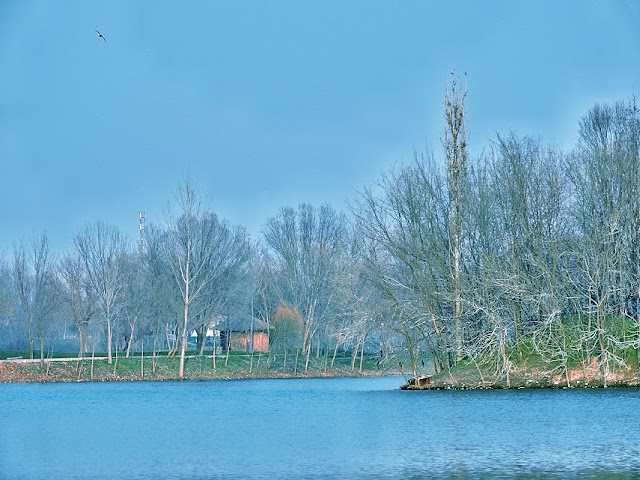Uzbekistan Landscapes
воскресенье, 14 февраля 2016 г.
пятница, 12 февраля 2016 г.
Registan. Samarkand.Uzbekistan
The Registan was the heart of the ancient city of Samarkand of the Timurid dynasty, now in Uzbekistan. The name Rēgistan (ریگستان) means "Sandy place" or "desert" in Persian.
The Registan was a public square, where people gathered to hear royal proclamations, heralded by blasts on enormous copper pipes called dzharchis - and a place of public executions. It is framed by three madrasahs (Islamic schools) of distinctive Islamic architecture.
Shah-i-Zinda. Samarkand city, Uzbekistan
Shah-i-Zinda (Uzbek: Shohizinda; Persian: شاه زنده, meaning "The Living King") is anecropolis in the north-eastern part of Samarkand, Uzbekistan.
The Shah-i-Zinda Ensemble includes mausoleums and other ritual buildings of 9-14th and 19th centuries. The name Shah-i-Zinda (meaning "The living king") is connected with the legend that Kusam ibn Abbas, the cousin of the prophet Muhammad was buried there. As if he came to Samarkand with the Arab invasion in the 7th century to preach Islam. Popular legends speak that he was beheaded for his faith. But he took his head and went into the deep well (Garden of Paradise), where he's still living now.
The Shah-i-Zinda complex was formed over nine (from 11th till 19th) centuries and now includes more than twenty buildings.
The ensemble comprises three groups of structures: lower, middle and upper connected by four-arched domed passages locally called chartak. The earliest buildings date back to the 11-12th centuries. Mainly their bases and headstones have remained now. The most part dates back to the 14-15th centuries. Reconstructions of the 16-19th centuries were of no significance and did not change the general composition and appearance.
The initial main body - Kusam-ibn-Abbas complex - is situated in the northeastern part of the ensemble. It consists of several buildings. The most ancient of them, the Kusam-ibn-Abbas mausoleum and mosque (16th century), are among them.
The upper group of buildings consists of three mausoleums facing each other. The earliest one is Khodja-Akhmad Mausoleum (1340s), which completes the passage from the north. The Mausoleum of 1361, on the right, restricts the same passage from the east.
The middle group consists of the mausoleums of the last quarter of the 14th century - first half of the 15th century and is concerned with the names of Timur's relatives, military and clergy aristocracy. On the western side the Mausoleum of Shadi Mulk Aga, the niece of Timur, stands out. This portal-domed one-premise crypt was built in 1372. Opposite is the Mausoleum of Shirin Bika Aga, Timur's sister.
Next to Shirin-Bika-Aga Mausoleum is the so-called Octahedron, an unusual crypt of the first half of the 15th century.
Near the multi-step staircase the most well proportioned buildings of the lower group is situated. It is a double-cupola mausoleum of the beginning of the 15th century. This mausoleum is devoted to Kazi Zade Rumi, who was the scientist and astronomer. Therefore the double-cupola mausoleum which was built by Ulugbek above his tomb in 1434-1435th has the height comparable with cupolas of the royal family's mausoleums.
The main entrance gate to the ensemble (Darvazakhana or the first chartak) turned southward was built in 1434-1435 under Ulugbek.
Guri Amir mausoleum. Samarkand city. Uzbekistan
The Gūr-i Amīr or Guri Amir (Uzbek: Amir Temur maqbarasi, Go'ri Amir, Persian: گورِ امیر), is a mausoleum of the Asian conqueror Tamerlane (also known as Timur) in Samarkand, Uzbekistan. It occupies an important place in the history of Persian-Mongolian Architecture as the precursor and model for later great Mughal architecture tombs, including Humayun's Tomb in Delhi and the Taj Mahal in Agra, built by Timur's Persianised descendants, the ruling Mughal dynasty of North India. It has been heavily restored.
Chirchik dam. Chirchik town. Tashkent region. Uzbekistan
Chirchiq also spelled as Chirchik (Uzbek: Chirchiq / Чирчиқ; Russian:Чирчик) is a city (1999 pop. 145,600) in Tashkent Region, Uzbekistan, about 32 km northeast of Tashkent, along the Chirchiq River. Chirchiq lies in the Chatkal Mountains.The population of Chirchiq on April 24th 2014 is approximately 167,842.
It is located at latitude 41° 28' 8N; longitude 69° 34' 56E, 582 meters above sea level.
The city was founded in 1935, when several local villages grew together as a consequence of the construction of a hydroelectric power station on the Chirchiq River.
Chirchiq is in the middle of an intensively cultivated area, producing mainly vegetables and fruits, including melons and grapes. A large electrochemical works produces fertilizer for the region's collective farms. Chirchiq's industries also include the production of ferroalloys and machinery for the agricultural and chemical industries.
Chirchiq is also a major winter recreation area in Tashkent Region. There is aski resort near the city, named Chimgan, that attract tourists from throughout Central Asia and Russia. A water diversion on the Chirchiq River just outside the city provides the major source of drinking water for Tashkent and other cities to the south.
Demography. The main ethnicity is Uzbek, followed by Kazakh.
Education.Medical college Industrial college The best and most popular school with an English learning bias is School #9.
Подписаться на:
Комментарии (Atom)















